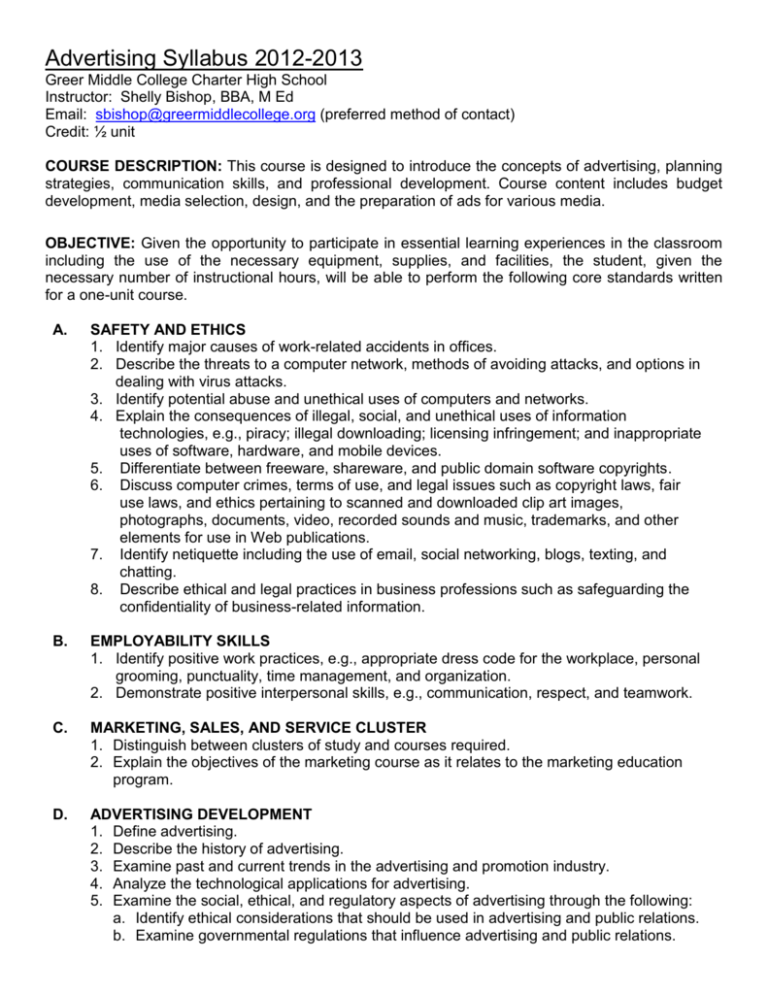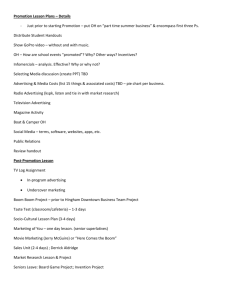2. Describe the history of advertising.
advertisement

Advertising Syllabus 2012-2013 Greer Middle College Charter High School Instructor: Shelly Bishop, BBA, M Ed Email: sbishop@greermiddlecollege.org (preferred method of contact) Credit: ½ unit COURSE DESCRIPTION: This course is designed to introduce the concepts of advertising, planning strategies, communication skills, and professional development. Course content includes budget development, media selection, design, and the preparation of ads for various media. OBJECTIVE: Given the opportunity to participate in essential learning experiences in the classroom including the use of the necessary equipment, supplies, and facilities, the student, given the necessary number of instructional hours, will be able to perform the following core standards written for a one-unit course. A. SAFETY AND ETHICS 1. Identify major causes of work-related accidents in offices. 2. Describe the threats to a computer network, methods of avoiding attacks, and options in dealing with virus attacks. 3. Identify potential abuse and unethical uses of computers and networks. 4. Explain the consequences of illegal, social, and unethical uses of information technologies, e.g., piracy; illegal downloading; licensing infringement; and inappropriate uses of software, hardware, and mobile devices. 5. Differentiate between freeware, shareware, and public domain software copyrights. 6. Discuss computer crimes, terms of use, and legal issues such as copyright laws, fair use laws, and ethics pertaining to scanned and downloaded clip art images, photographs, documents, video, recorded sounds and music, trademarks, and other elements for use in Web publications. 7. Identify netiquette including the use of email, social networking, blogs, texting, and chatting. 8. Describe ethical and legal practices in business professions such as safeguarding the confidentiality of business-related information. B. EMPLOYABILITY SKILLS 1. Identify positive work practices, e.g., appropriate dress code for the workplace, personal grooming, punctuality, time management, and organization. 2. Demonstrate positive interpersonal skills, e.g., communication, respect, and teamwork. C. MARKETING, SALES, AND SERVICE CLUSTER 1. Distinguish between clusters of study and courses required. 2. Explain the objectives of the marketing course as it relates to the marketing education program. D. ADVERTISING DEVELOPMENT 1. Define advertising. 2. Describe the history of advertising. 3. Examine past and current trends in the advertising and promotion industry. 4. Analyze the technological applications for advertising. 5. Examine the social, ethical, and regulatory aspects of advertising through the following: a. Identify ethical considerations that should be used in advertising and public relations. b. Examine governmental regulations that influence advertising and public relations. c. Examine global differences and laws as to their effect on advertising. 6. Explain the benefits and advantages of advertising. 7. Compare promotional and institutional advertising. E. ADVERTISING PLANNING 1. Determine the impact of advertising on consumer behavior. 2. Define market segmentation. 3. Identify how to select a target market. 4. Examine the methods of obtaining data. 5. Examine how marketing research is used. 6. Identify the steps of the research process. 7. Explain the impact of technology on the marketing research process. 8. Describe the various advertising objectives and their relationship to the message strategy of a campaign. 9. Identify the components of the promotional mix. 10. Explain the role of promotion as a marketing function. 11. Explain the elements of sales promotion and its relationship to the ad campaign. 12. Assess the impact of advertising on the elements of the marketing mix. 13. Discuss different ways to overcome global cultural barriers. F. ADVERTISING CREATIVE 1. Explain how a brand is created. 2. Explain why creativity is important in advertising. 3. Describe the creative process in an advertising agency. 4. Explain the parts of a printed advertisement. 5. Explain the different types/timing of broadcast media such as 10/30/60 second spots, donuts, sing-outs, etc. 6. Describe a storyboard and how it is used. 7. Describe the creative guidelines for television. 8. Examine the use of advertising and public relations by marketers. 9. Describe the components of a publicity/press news release. 10. Demonstrate how to write a publicity/press release. 11. Prepare an advertisement utilizing computer graphics, layout, storyboards, etc., to develop advertisements for selected media such as broadcast and print. G. ADVERTISING MEDIA PLACEMENT 1. Explain the advantages and disadvantages of various types of media. 2. Determine criteria for selecting/purchasing different forms of media. 3. Demonstrate how to calculate media costs. 4. Define cooperative advertising. 5. Describe the benefits of advertising campaign activities. 6. Analyze advertising and public relations objectives as they relate to profitability and/or effectiveness. 7. Describe the role of support media such as P-O-P, direct marketing, etc. H. ADVERTISING/PROMOTIONAL ACTIVITIES 1. Explain the basic ways in which companies determine their promotional budgets. 2. Prepare an advertising/promotional budget. 3. Select a product/service for advertising and promotion. 4. Select promotional media. 5. Coordinate promotional and selling activities. 6. Develop an advertising/promotional campaign. 7. Explain the techniques of evaluating sales promotion activities. I. PROFESSIONAL DEVELOPMENT 1. Identify careers in advertising. 2. Examine professional development resources through trade organizations. 3. Examine the structure of the advertising industry, including advertisers, advertising agencies, and support organizations. 4. Write a resume and a cover letter for a career in the ad industry. II. INSTRUCTIONAL MATERIAL AND RESOURCES • Computers (as needed) • Advertising, Business 2000, 2001, South-Western Publishing, Thomson Learning. One textbook is checked out to each student. Student needs to provide pen, pencil, and paper for taking notes. A highlighter is also helpful. III. GRADING/EVALUATION AND ASSESSMENT: South Carolina Grading Scale 2012-2013 A 93-100 B 85-92 C 77-84 D 70-76 F 0-69 Following are performance levels of the GMC grading scale: 90-100 = Mastery Level 80-89 = Proficiency Level 0-79 = Below Proficiency If a student receives below proficiency (0-79) on a major graded assignment, another opportunity will be given to master the material with further instruction through Academic Assistance. Retesting will follow the additional instruction, if a student attends Academic Assistance as outlined in the GMC student handbook. South Carolina law states that a student must attend at least 85 days of a 90 day semesterlong class, therefore only FIVE (5) total absences are permitted in this class. A student must make up all work missed within five days and it is the student’s responsibility to request the missed work. When a student is absent, he/she misses valuable instruction and the opportunity to work in class and/or with their group. If a student is absent, my expectation is that the work is completed at home or in AA (including group projects.) Advertising AA is Wednesday after school. Class assessment will be calculated using the following percentages. • 50% Classwork/Daily assignments (minor) • 50% Test/Project grades (major) Grading Policies developed by GMC faculty states that there will be a minimum of three (3) major grade and nine (9) minor grades each grading period (nine weeks.) Semester Grade is weighted as follows: • 1st /3rd Nine Weeks 40% • 2nd/4th Nine Weeks 40% • Semester Exam 20% IV. STUDENT RECORDS A hard copy and an electronic record will be kept for student grades. Progress reports are provided by the school for the student/parents in the middle of each nine weeks. Students are provided a detailed hard copy of their progress report/report card before each grading period, enabling a partnership and accountability to ensure grades that are entered into the computer are correct. Report cards will be given out by the school at the end of each nine week grading period. A parent or student may communicate needs or concerns via e-mail. Parents are welcome to review grades on the Parent Portal website. Grades are generally updated at least weekly. V. CLASSROOM RULES AND PROCEDURES Students must follow all rules, policies and procedures in the GMC handbook. Additional classroom guidelines are as follows: Be on time to class Be prepared for class Follow dress code Respect the teacher, others and yourself Consequences Students and Families choose to attend GMC. As a result, it is expected that the rules and procedures will be followed. If a student chooses not to follow the rules, there will usually be a warning given. For continuous violations, parents will be contacted and the student may be referred to school administration for further discipline. VI. ADDITIONAL INFORMATION LATE WORK No credit is given for minor assignments that are turned in late. A student will receive a zero (0) if an assignment is not turned in on time. When an assignment is given, it is due at the beginning of the class period on the due date. Students are not permitted to leave class (or be tardy) to use a printer or complete a project. Considering that Advertising is an elective, the students are given sufficient time to complete most of their projects in class. If a major assignment (test, project, etc) is late, students will receive a zero (0) for the grade, attend AA and be allowed to turn it in as a retest grade (70%) with the week of the original due date. Students are typically given at least five (5) school days notice of an upcoming test. If a student is absent on the day of the test, it is in his/her best interest to take the test as soon as they return to school. Tests are typically graded, returned and reviewed within a day or two. RESTROOMS There is sufficient time between classes (eight minutes) to use the restroom. As high school students that have experience in changing classes, it is expected that students use the restroom between classes. Occasionally, there may be a need to use the restroom during class. Instructions will be given at the beginning of school regarding the restroom procedure. Students are not to interrupt the teacher or class discussion to ask to go to the restroom. ASSIGNMENT HEADING Every assignment/test should contain the student’s first and last name, the date (always available on the white boards), and the class period. Failure to include a proper heading may result in a deduction of five points from the assignment grade. PROJECTS Greer Middle College Charter High School is a college preparatory high school that emphasizes project based learning. Projects (both individual and group) that are submitted for a grade should show evidence of high school level effort and ability. A project that is created at the “last minute” will typically receive a grade that reflects the “last minute” effort. Information contained in this syllabus is intended to be a guideline for the Advertising course and is not intended to include every possible classroom scenario. Should unforeseen circumstances result in changes being made to the syllabus, the changes will be highlighted on my website.






